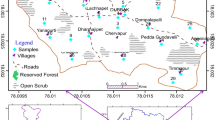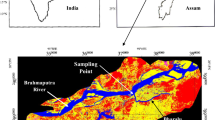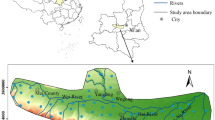Abstract
In the pursuit of advancing water quality assessment methodologies, particularly for the purposes of irrigation, it is of utmost importance to enhance our understanding of water quality to effectively manage water resources. Recognizing this necessity, our study introduces the application of the Entropy method, for the first time, in the assessment of irrigation water quality in the Urmia plain groundwater resources. The approach coined as entropy weighted irrigation water quality index (EIWQI) has been devised. Key indicators of irrigation water quality, namely, Sodium Absorption Ratio (SAR), Residual Sodium Carbonate (RSC), Sodium percentage (Na%), Total Hardness (TH), and Electrical Conductivity (EC), were calculated for 69 groundwater samples, alongside the determination of major ions present in the groundwater, including Ca2+, Mg2+, Na+, K+, So42−, Cl−, HCo3−, and CO32−. Subsequently, the water quality index was quantified through the implementation of the entropy weighted method. The proposed EIWQI enables the classification of irrigation water quality into four categories: excellent, good, doubtful, and unsuitable. Following the application of the EIWQI to the aforementioned data points, the groundwater of the study area was categorized as good (42.02%), doubtful (52.17%), and unsuitable (5.79%). To assess the accuracy of the proposed methodology, the EIWQI calculation results were compared with the SAR, Na%, and RSC values obtained from the sample points, as well as their fuzzy overlay outputs. Performance criteria such as Mean Absolute Deviation (MAD), Mean Absolute Percentage Error (MAPE), Mean Square Error (MSE), and Root Mean Square Error (RMSE) were utilized, all of which substantiated the accuracy of the model, yielding values of 0.217, 8.574, 0.217, and 0.466, respectively. These results underscore the precision and applicability of the proposed methodology.





Similar content being viewed by others
Data availability
Not available.
References
Ahmed AN, Othman FB, Afan HA, Ibrahim RK, Fai CM, Hossain MS, Ehteram M (2019) Machine learning methods for better water quality prediction. J Hydrol 578:124084. https://doi.org/10.1016/j.jhydrol.2019.124084
Akter T, Jhohura FT, Akter F, Chowdhury TR, Mistry SK, Dey D, Barua MK, Islam MA, Rahman M (2016) Water Quality Index for measuring drinking water quality in rural Bangladesh: a cross-sectional study. J Heal Popul Nutr 35:1–12. https://doi.org/10.1186/s41043-016-0041-5
Al-Hadithi M, Hasan K, Algburi A, Al-Paruany K (2019) Groundwater quality assessment using irrigation water quality index and GIS in Baghdad, Iraq. JJEES 10(1):15–20
Amiri V, Rezaei M, Sohrabi N (2014) Groundwater quality assessment using entropy weightedWater Quality Index (EWQI) in Lenjanat, Iran. Environ Earth Sci 72:3479–3490. https://doi.org/10.1007/s12665-014-3255-0
Amiri V, Nakhaei M, Lak R, Kholghi M (2016) Investigating the salinization and freshening processes of groundwater through major ion and trace element indicators: Urmia plain NW of Iran. Environ Monit Assess 188:233. https://doi.org/10.1007/s10661-016-5231-5
Amiri V, Nakhaei M, Lak R (2017) Using radon-222 and radium-226 isotopes to deduce the functioning of a coastal aquifer adjacent to a hypersaline lake in NW Iran. J Asian Earth Sci 147:128–147. https://doi.org/10.1016/j.jseaes
Ayers R, Westcott D (1985) Water quality for agriculture. 29. Food and Agriculture Organization of the United Nations, Rome
Azzirgue M, Cherif Kh, Tchakoucht TA, El Azhari H, Salmoun F (2022) Testing groundwater quality in Jouamaa Hakama Region (north of Morocco) using water quality indices (WQIs) and fuzzy logic method: an exploratory study. Water 14:3028. https://doi.org/10.3390/w14193028
Batarseh M, Imreizeeq E, Tilev S, Al Alaween M, Suleiman W, Al Remeithi AM, Al Tamimi MK, Al Alawneh M (2021) Dataset for the physio-chemical parameters of groundwater in the Emirate of Abu Dhabi, UAE. Data Brief 38:107353. https://doi.org/10.1016/j.dib.2021.107353
Bui DT, Khosravi K, Tiefenbacher J et al (2020) Improving prediction of water quality indices using novel hybrid machine-learning algorithms. Sci Total Environ. https://doi.org/10.1016/j.scitotenv.2020.137612
Burri NM, Weatherl R, Moeck C, Schirmer M (2019) A review of threats to groundwater quality in the anthropocene. Sci Total Environ 684:136–154. https://doi.org/10.1016/j.scitotenv.2019.05.236
Çadraku HS (2021) Groundwater quality assessment for irrigation: Case study in the Blinaja river basin, Kosovo. Civil Eng J 7(9):1515–1528. https://doi.org/10.28991/cej-2021-03091740
Chidambaram S, Prasanna MV, Nepolian M, Pradeep K, Banajarani P, Thivya C, Thilagavathi R (2022) Groundwater quality assessment for irrigation by adopting new suitability plot and spatial analysis based on fuzzy logic technique. Environ Res 204:111729. https://doi.org/10.1016/j.envres.2021.111729
Chowdury MSU, Emran T, Bin GS, Pathak A, Alam MM, Absar N, Andersson K, Hossain MS (2019) IoT based real-time river water quality monitoring system. Proced Comput Sci 155:161–168
Das A, Das SS, Chowdhury NR, Joardar M, Ghosh B, Roychowdhury T (2020) Quality and health risk evaluation for groundwater in Nadia district, West Bengal: an approach on its suitability for drinking and domestic purpose. Groundw Sustain Dev 10:100351
Docheshmeh Gorgij A, Wu J, Asghari Moghadam A (2019) Groundwater quality ranking using the improved entropy TOPSIS method: a case study in Azarshahr plain aquifer, east Azerbaijan Iran. Hum Ecol Risk Assess 25(1–2):176–190. https://doi.org/10.1080/10807039.2018.1564235
Docheshmeh Gorgij A, Askari Gh, Taghipour AA, Jami M, Mirfardi M (2023) Spatiotemporal forecasting of the groundwater quality for irrigation purposes, using deep learning method: long short-term memory (LSTM). Agri Water Manag 227:108088. https://doi.org/10.1016/j.agwat.2022.108088
El Asri H, Larabi A, Faouzi M (2019) Climate change projections in the Ghis-Nekkor region of Morocco and potential impact on groundwater recharge. Theor Appl Climatol 138:713–727. https://doi.org/10.1007/s00704-019-02834-8
El Mountassir O, Bahir M, Ouazar D, Ouhamdouch S, Chehbouni A, Ouarani M (2020) The use of GIS and water quality index to assess groundwater quality of krimat aquifer (Essaouira; Morocco). SN Appl Sci. https://doi.org/10.1007/s42452-020-2653z
FAO (2017) Water for sustainable food and agriculture: a report produced for the G20 Presidency of Germany. FAO, Rome
Gao Y, Qian H, Ren W, Wang H, Liu F, Yang F (2020) Hydrogeochemical characterization and quality assessment of groundwater based on integrated-weight water quality index in a concentrated urban area. J Clean Prod. https://doi.org/10.1016/j.jclepro.2020.121006
Ghalib HB (2017) Groundwater chemistry evaluation for drinking and irrigation utilities in east Wasit province, Central Iraq. Appl Water Sci 7:3447–3467
Guey-Shin Sh, Bai-You Ch, Chi-Ting Ch, Pei-Hsuan Y, Tsun-Kuo Ch (2011) applying factor analysis combined with kriging and information entropy theory for mapping and evaluating the stability of groundwater quality variation in Taiwan. Int J Environ Res Public Health 8:1084–1109. https://doi.org/10.3390/ijerph8041084
Houemenou H, Tweed S, Dobigny G, Mama D, Alassane A, Silmer R, Babic M, Ruy S, Chaigneau A, Gauthier P, Socohou A, Dossou HJ, Badou S, Leblanc M (2020) Degradation of groundwater quality in expanding cities in West Africa. A case study of the unregulated shallow aquifer in Cotonou. J Hydrol 582:124438. https://doi.org/10.1016/j.jhydrol.2019.124438
Ismail AH, Muntasir AH, Channo RJ (2015) Groundwater quality assessment in urban area of Baghdad, Iraq, using multivariate statistical techniques. Eng Technol J 33:463–476
Ismail AH, Hassan G, Sarhan A (2020) Hydrochemistry of shallow groundwater and its assessment for drinking and irrigation purposes in Tarmiah district, Baghdad governorate, Iraq. Gr Sustain Dev 10:100300
Jahin HS, Abuzaid AS, Abdellatif AD (2020) Using multivariate analysis to develop irrigation water quality index for surface water in Kafr El-Sheikh Governorate, Egypt. Environ Technol Innov 17:100532. https://doi.org/10.1016/j.eti.2019.100532
Lee S, Park JR, Joo JC, Ahn CH (2022) Application of WQIEUT and TSIKO for comprehensive water quality assessment immediately after the construction of the Yeongju Multipurpose Dam in the Naeseong Stream Basin Republic of Korea. Sci Tot Environ 819:152997. https://doi.org/10.1016/j.scitotenv.2022.152997
Li P, Qian H, Wu JH (2010) Groundwater quality assessment based on improved Water Quality Index in Pengyang County, Ningxia North West China. E-J Chem 7:209–216
Maity S, Maiti R, Senapati T (2022) Evaluation of spatio-temporal variation of water quality and source identification of conducive parameters in Damodar River, India. Environ Monit Assess 194(4):308. https://doi.org/10.1007/s10661-022-09955-0
Meireles A, Andrade EM, Chaves L, Frischkorn H, Crisostomo LA (2010) A new proposal of the classification of irrigation water. Rev Cienc A Gron 41(3):349–357
Mutlu E, Kurnaz A (2018) Assessment of physicochemical parameters and heavy metal pollution in Celtek Pond Water. Indian J Geo-Mar Sci 47(6):1185–1192
Mutlu E, Uncumusaoglu AA (2018) Analysis of spatial and Temporal water pollution patterns in Terzi Pond by using multivariate statistical methods. Fresenius Environ Bullet 27:2900–2912
Mutlu E, Uncumusaoglu AA (2022) Assessment of spatial and temporal water pollution patterns in Aydos River (Turkey) by using water quality index and multivariate statistical methods. Desalin Water Treat 246:196–211
Passos ALL, Muniz DHF, Rangel LP, Oliveira-Filho EC (2019) Selection of variables in the definition of a water quality index for the Brazilian Federal District. Rev Ambiente Água 14:16. https://doi.org/10.4136/ambi-agua.2385
Piper AM (1944) A graphic procedure in the geochemical interpretation of water-analyses. Eos Trans Am Geophys Union 25(6):914–928
Rahman MM, Bodrud-Doza M, Siddique T, Zahid A, Islam A (2020) Spatiotemporal distribution of fluoride in drinking water and associated probabilistic human health risk appraisal in the coastal region Bangladesh. Sci Total Environ 724:138316. https://doi.org/10.1016/j.scitotenv
Richards LA (1954) Diagnosis and improvement of saline and alkali soils. United States Department of Agriculture, Washington DC
Sawyer CN, McCarty PL (1978) Chemistry for environmental engineering, 3rd edn. McGraw-Hill Book Co, New York
Siebert S, Burke J, Faures J-M, Frenken K, Hoogeveen J, Doll P, Portmann FT (2010) Groundwater use for irrigation – a global inventory. Hydrol Earth Syst Sci 14:1863–1880. https://doi.org/10.5194/hessd-7-3977-2010
Simsek C, Gunduz O (2007) IWQ index: A GIS integrated technique to assess irrigation water quality. Environ Monitor Assess 128:277–300. https://doi.org/10.1007/s10661-006-9312-8
Singh S, Ghosh NC, Gurjar S, Krishan G, Kumar S, Berwal P (2018) Index-based assessment of suitability of water quality for irrigation purpose under Indian conditions. Environ Monit Assess 190:190. https://doi.org/10.1007/s10661-017-6407-3
Uncumusaoglu AA, Mutlu E (2021) Water quality assessment in Karaboğaz Stream Basin (Turkey) from a Multi-statistical perspective. Pol J Environ Stud 30(5):4747–4759. https://doi.org/10.15244/pjoes/132909
Uncumusaoglu AA, Mutlu E (2022) Water quality index and multivariate statistical approach in assessing the quality of irrigation water of Caykoy pond. Fresenius Environ Bull 31(3A):3447–3459
Valentini M, Dos Santos GB, Muller Vieira B (2021) Multiple linear regression analysis (MLR) applied for modeling a new WQI equation for monitoring the water quality of Mirim Lagoon, in the state of Rio Grande do Sul—Brazil. SN Appl Sci 3:1–11. https://doi.org/10.1007/s42452-020-04005-1
Wilcox LV (1955) Classification and Use of Irrigation Water. US Department of Agriculture, Circular 969, Washington DC
World Health Organization (WHO) (2011) Guidelines for drinking-water quality, 4th edn. WHO press, Geneva
Wu J, Zhang Y, Zhou H (2020) Groundwater chemistry and groundwater quality index incorporating health risk weighting in Dingbian County Ordos basin of northwest China. Chem Der Erde. https://doi.org/10.1016/j.chemer.2020.125607
Zhu JJ, Yu LZ, Xu TL, Wei X, Yang K (2019) Comparison of water quality in two catchments with different forest types in the headwater region of the Hun River, Northeast China. J Res 30:565–576. https://doi.org/10.1007/s11676-018-0688-4
Funding
The authors of manuscript, Alireza Docheshmeh Gorgij and Mohammad Mehdi Moayeri, approve that the present study has not been submitted elsewhere and it is not under review by another journal. The authors, Also, declare that No funds, grants, or other support were received during the preparation of this manuscript, and it should be stated that, the authors have no relevant financial or non-financial interests to disclose.
Author information
Authors and Affiliations
Contributions
All authors contributed to the study conception and design. Material preparation, data collection and analysis were performed by ADG and MMM. The first draft of the manuscript was written by ADG and both authors commented on previous versions of the manuscript. All authors read and approved the final manuscript.
Corresponding author
Ethics declarations
Competing interests
The authors declare no competing interests.
Additional information
Publisher's Note
Springer Nature remains neutral with regard to jurisdictional claims in published maps and institutional affiliations.
Rights and permissions
Springer Nature or its licensor (e.g. a society or other partner) holds exclusive rights to this article under a publishing agreement with the author(s) or other rightsholder(s); author self-archiving of the accepted manuscript version of this article is solely governed by the terms of such publishing agreement and applicable law.
About this article
Cite this article
Gorgij, A.D., Moayeri, M.M. Proposing a novel method for the irrigation water quality assessment, using entropy weighted method, entitled: “EIWQI”. Environ Earth Sci 82, 462 (2023). https://doi.org/10.1007/s12665-023-11150-4
Received:
Accepted:
Published:
DOI: https://doi.org/10.1007/s12665-023-11150-4




